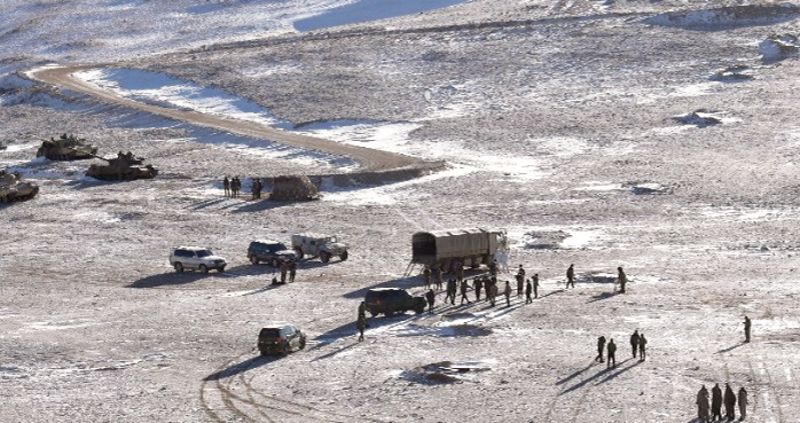
Strategic blunder: Disengagement from the Kailash ridge without Chinese guarantees of vacation from other friction points is no guarantee of peace. Reuters
Maj Gen Ashok K Mehta (retd)
Military Commentator
The Chinese have hardened their defences along the LAC and refused to withdraw from Hot Springs PP15, indicating their intention to hold on to the remaining friction points in east Ladakh for another winter. They have also refused to discuss the 15-km deep intrusion in the Depsang bulge in the strategic DBO sector, leave alone vacating other incursions in Demchok. This is a case of “we told you so”.
I had earlier pointed to the perils of a segmented Indian withdrawal from the friction points on the Kailash range for the Chinese vacating Fingers on the North Bank of Pangong Tso, forfeiting a decisive strategic advantage. The Chinese statement after the recent 13th round of talks clearly conveyed its unwillingness to withdraw from other intrusion points.
The caustic exchange between the two sides is unprecedented. India has blamed China for not being agreeable to constructive suggestions as well as failing to provide any forward-looking proposals. China’s stern response was that India was making ‘unreasonable and unrealistic demands and instead of misjudging the situation, the Indian side should cherish the hard-won situation in the China-India border areas.’
In plain language, Beijing is telling New Delhi to be content with what it has achieved. China is belittling India.
Statements from the Chinese foreign ministry have accused India of following a forward policy in an explicit invocation of 1962. The fresh face-offs in Barahoti, Uttarakhand, and Tawang, Arunachal Pradesh, in August-September reflect China’s unrelenting posture on the LAC, corresponding with India’s determination to strengthening its partnerships with Quad, Malabar exercises and other Indo-Pacific strategies.
The Army Chief, Gen Manoj Naravane, has confirmed Chinese troop, training and infrastructure build-up from Ladakh to Arunachal Pradesh and, strangely, he wondered why this was happening, adding, “I wish I knew.”
The military escalation is on despite two face-to-face meetings between Foreign Minister S Jaishankar and his counterpart Wang Yi during the SCO meetings in Dushanbe in July and September. Jaishankar described the India-China relations at the “lowest ebb.”
Clearly, China has closed the door on a full and complete return to peace and tranquility — a euphemism for the restoration of status quo ante, April 2020 — in clear violation of the five-point agreement reached between the two ministers at Moscow last September.
The PLA has succeeded in creating buffer zones in Galwan, Gogra and Pangong Tso on the Indian territory and blocked patrolling in Depsang between traditional Patrolling Points 10 to 13. Several grazing grounds in Gogra and Chushul have been lost to the Chinese. Some reports suggest that they are denying access to Indian patrols from PP 4 to PP 9 in the shadow of the Karakoram Pass.
China has continued to develop infrastructure at a hectic pace. In August, the G6 — the Beijing-to-Lhasa Expressway — was completed. In addition, the 295-km road from Lhasa to Nagque at 4,500-m height will connect the Central and Western Theatre Commands responsible for operations against India. In June, the railway between Lhasa and Nyinchi on the Arunachal Pradesh border was completed. President Xi Jinping, on his first visit to Tibet in July, travelled on it. Two live fire exercises were held in the Xinjiang military district in September. China has deployed its S400 air defence missile system in Demchok. These missiles will be effective against Indian aircraft, covering all of J&K, including Ladakh.
Xi is out to prove that the PLA is not allergic to high-altitude deployment, as Indian writers have indicated. However, it is true that the PLA was never deployed earlier along the LAC as the PLA and border guards used to patrol the LAC on horseback or vehicles. It is also true that at some places, troops were rotated every 10 days till their acclimatisation state improved.
On the Indian side, infrastructure development and deployment of heavy weapons has intensified. My meetings with soldiers deployed up front reveal an avoidably heavy troop density. At places, a company is deployed against a PLA platoon, with another company held in depth. Troops deployed at 17,000 ft are being rotated in two months. In Siachen, they are rotated in three months.
The main issue faced by troops is the high red blood cell count, which shoots up in high altitude and due to lack of roughage in the diet. Hill troops naturally fare better than those from the plains. High-altitude casualties from frostbite and chilblains were initially heavy as the troops were rushed without proper acclimatisation from 10,000 ft to 15-to-17,000 ft. The habitat has improved considerably lately. The Army’s strategic pivot towards the north with 1 Corps in Ladakh is complete.
General Naravane’s fears of the LAC turning into an LOC will be realised as China imposes costs it can afford on India for daring Beijing on issues of national sovereignty and China's rejuvenation, as Xi aspires for another 10- year term as China's sole ruler next year during the 20th party congress.
On February 11, when India agreed to mutual troop withdrawal from Pangong north and south even though India held dominating heights on the Kailash range, Defence Minister Rajnath Singh, who considers VD Savarkar as India’s first and biggest defence and strategic expert, indicated that talks on other intrusions at Hot Springs, Gogra and Depsang would be taken up within 48 hours of disengagement at Pangong Tso. The pullback from Gogra happened six months later and, since then, the only exchange has been of diplomatic abuse. India's lightning seizure of strategic heights on the Kailash Range, coupled with moves to capture the 21,000-ft-high junction of Fingers 4 and 5 ridge lines (which was called off), was a game-changer.
The disengagement from the Kailash ridge without Chinese guarantees of vacation from other friction points, including Depsang, was a strategic blunder. But our brave jawans in Pangong Tso have displayed a giant sign ‘Never Give Up’ as India’s tallest and biggest Tricolour flutters from a hilltop in Ladakh. As many as 13 rounds of corps commander-level talks, 10 at the Major-General level, 55 at the Brigadier level and 1,540 hotline calls later, China has succeeded in annexing Indian territory and promulgating its 1959 claim line in Ladakh, which was preventable.
Join Whatsapp Channel of The Tribune for latest updates.




























